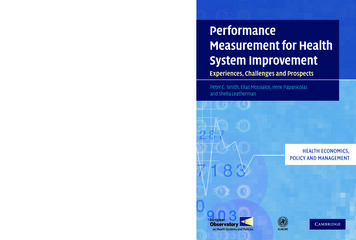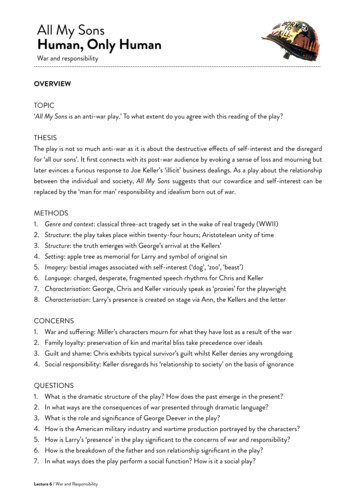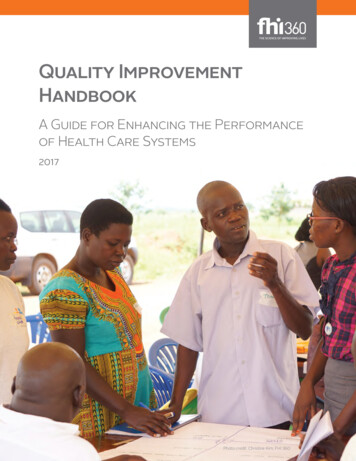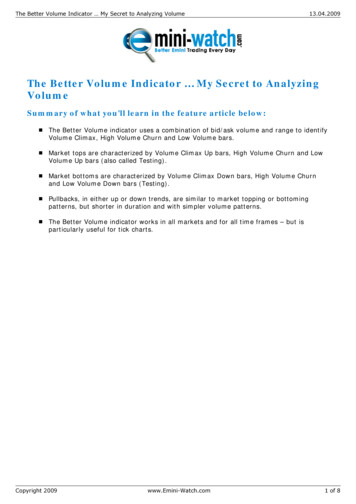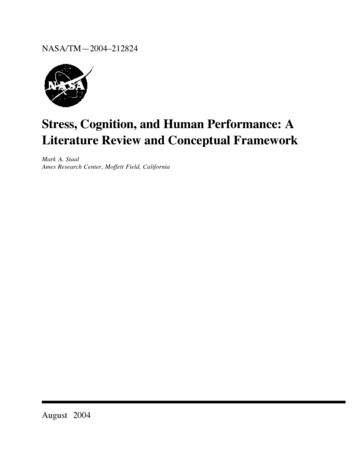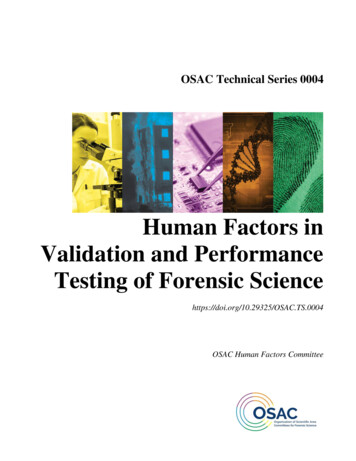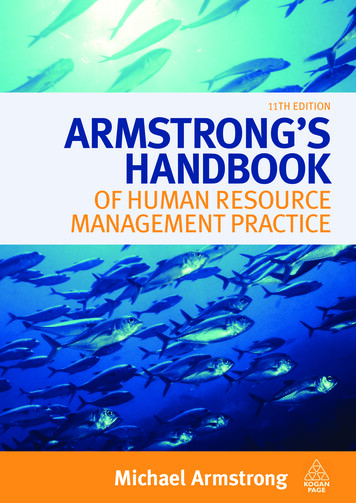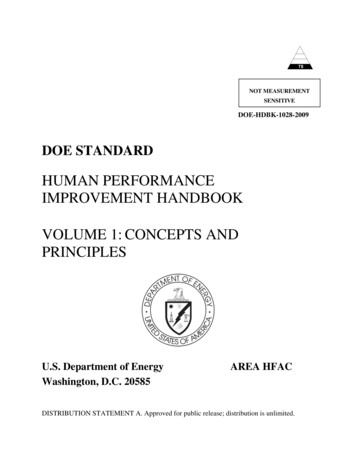
Transcription
NOT MEASUREMENTSENSITIVEDOE-HDBK-1028-2009DOE STANDARDHUMAN PERFORMANCEIMPROVEMENT HANDBOOKVOLUME 1: CONCEPTS ANDPRINCIPLESU.S. Department of EnergyWashington, D.C. 20585AREA HFACDISTRIBUTION STATEMENT A. Approved for public release; distribution is unlimited.
Available on the Department of EnergyTechnical Standards ProgramWeb site athttp://tis.eh.doe.gov/techstds/
DOE-HDBK-1028-2009VOLUME 1: CONCEPTS AND PRINCIPLESPREFACE . vReading The Handbook . viCHAPTER 1 - INTRODUCTION TO HUMAN PERFORMANCE.1-1OVERVIEW. 1-1Perspective on Human Performance and Events. 1-10Human Performance for Engineers and Knowledge Workers . 1-11The Work Place. 1-11Individuals, Leaders, and Organizations . 1-12HUMAN PERFORMANCE. 1-12Behavior . 1-13ANATOMY OF AN EVENT . 1-14Event .1-14Initiating Action. 1-14Flawed Controls . 1-15Error Precursors. 1-15Latent Organizational Weaknesses. 1-15STRATEGIC APPROACH FOR HUMAN PERFORMANCE . 1-16Reducing Error . 1-16Managing Controls . 1-17PRINCIPLES OF HUMAN PERFORMANCE . 1-19REFERENCES. 1-21CHAPTER 2 - REDUCING ERROR .2-1HUMAN FALLIBILITY (Essential Reading) . 2-1Common Traps of Human Nature . 2-1Unsafe Attitudes and At-Risk Behaviors . 2-4Slips, Lapses, Mistakes, Errors and Violations. 2-8Active Errors. 2-8Latent Errors . 2-9Violations. 2-10Dependency and Team Errors . 2-11Equipment Dependencies . 2-11i
DOE-HDBK-1028-2009Team Errors . 2-12Personal Dependencies . 2-15PERFORMANCE MODES (Essential Reading) . 2-16Information Processing, Memory, and Attention. 2-16Generic Error Model System (GEMS) . 2-20Skill-Based Performance. 2-21Examples of Skill-Based Activities . 2-22Skill-Based Error Mode – Inattention. 2-22Rule-Based Performance . 2-23Examples of Rule-Based Activities. 2-23Rule-Based Error Mode . 2-24Knowledge-Based Performance. 2-25Examples of Knowledge-Based Activities . 2-26Knowledge-Based Error Mode . 2-26How Performance Modes Can be Used . 2-27Mental Models.2-28Assumptions. 2-29Mental Biases – Shortcuts. 2-29Conservative Decisions. 2-30ERROR-LIKELY SITUATIONS (Essential Reading). 2-30Error Precursors. 2-31Common Error Precursors . 2-32ERROR-PREVENTION TOOLS. 2-33ATTACHMENT A – ERROR PRECURSORS. 2-35ATTACHMENT B – COMMON ERROR-PRECURSOR DESCRIPTIONS . 2-39REFERENCES. 2-45CHAPTER 3 - MANAGING CONTROLS .3-1Controls. 3-1Severity of Events . 3-3The Organization’s Role in Controls. 3-3Defense Functions . 3-4Reliability of Controls . 3-4DEFENSE-IN-DEPTH . 3-5Engineered Controls . 3-5Administrative Controls . 3-6Cultural Controls – Values, Beliefs, Attitudes . 3-8ii
DOE-HDBK-1028-2009Work Group Norms . 3-9Leadership Practices. 3-10Common Flaws with Cultural Controls . 3-10Oversight Controls . 3-10Senior Management Team Focus on Human Performance . 3-11Performance Improvement Processes . 3-11Human Performance Improvement Plans . 3-12PERFORMANCE MODEL . 3-12Organizational Effectiveness. 3-13Organizational Factors . 3-14Job-Site Conditions . 3-14Worker Behaviors. 3-15Plant Results . 3-15MANAGING CONTROLS – PERFORMANCE IMPROVEMENT MODEL. 3-15METHODS (Tools) FOR FINDING LATENT ORGANIZATIONAL CONDITIONS . 3-17Self-Assessments . 3-18Behavior Observations . 3-18Problem Reporting . 3-19Benchmarking . 3-19Performance Indicators and Trending . 3-20Operating Experience . 3-20Independent Oversight . 3-21Problem Analysis . 3-22Management Oversight . 3-23Surveys and Questionnaires . 3-23Corrective Action Program . 3-23Change Management. 3-24APPENDIX A: WARNING FLAGS—FACTORS THAT DEFEAT CONTROLS . 3-25REFERENCES. 3-27CHAPTER 4 - CULTURE AND LEADERSHIP .4-1ORGANIZATIONAL CULTURE. 4-1SAFETY CULTURE .4-2How Organizations Process Information . 4-5LEADERSHIP . 4-11Leader’s Role . 4-11Production and Prevention: Competing Purposes. 4-12iii
DOE-HDBK-1028-2009KEY LEADERSHIP PRACTICES . 4-13Facilitate Open Communication . 4-13Promote Teamwork. 4-13Reinforce Expectations . 4-14Eliminate Latent Organizational Weaknesses . 4-16Value the Prevention of Error . 4-17BEHAVIOR ENGINEERING MODEL (BEM) . 4-17CREATE A JUST CULTURE. 4-23The Blame Cycle. 4-23Categories of Violations . 4-23The Foresight Test . 4-24The Substitution Test . 4-25The Culpability Decision Tree . 4-25ATTACHMENT A – PERFORMANCE GAP ANALYSIS . 4-27ATTACHMENT B – CULPABILITY DECISION TREE . 4-29ATTACHMENT C – ESTABLISHING A REPORTING CULTURE . 4-31REFERENCES. 4-33CHAPTER 5 - HUMAN PERFORMANCE EVOLUTION .5-1INTRODUCTION. 5-1A Perspective on Organizations . 5-1FACTORS THAT IMPACT ORGANIZATIONS. 5-2Production
28.06.2006 · performance courses, which were patterned on the INPO model. This handbook reflects heavily on the human performance research and practical applications so expertly chronicled in INPO’s Human Performance Fundamentals Course Reference (2002) and its later revision of the material in Human Performance Reference Manual, INPO 06-003 (2006). The .

